Dragons are commonly depicted with Serpentine or Reptilian features, hatching from eggs, and typically having a scaly body.
Listed below are the more unusual and lesser known dragons.
|
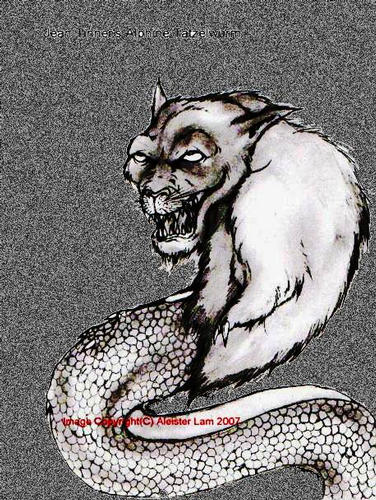 The Alphine Tatzelwurm
The Alphine Tatzelwurm
In 1954, a farmer staying in Palermo, Sicily, reported sightings of a unsual creature with a feline head with two tiny fore-arms and a serpentine body. The farmer, Jean Tinner said in the wee hours of the morning he heard his pigs squealing violently and he went to his barn to investigate. He saw this strange creature attacking one of his pigs and must have alerted the animal that it quickly made its escape. Several other farmers also reported sightings of a similar monster attacking their livestock. Jean Tinner's Tatzelwurm is more unique in that the creature described has a less visible fore-legs, more like vestiges and a serpentine body able to reared up in coils.
|
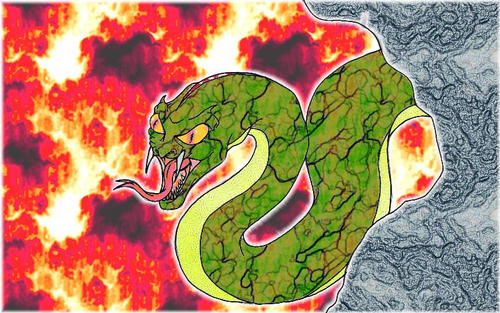 The Serpent of Carthage
The Serpent of Carthage
The Romans and the Carthaginians went into battle over a dispute for the possession of the island of Sicily. Rome despatched its bravest general, Marcus Attilus Regulus, who had no idea that when his troops set foot in enemy territory; they not just had to battle the Carthaginians but a 120 feet long giant serpent. While crossing the river Bagradas, which is located between Utica and Carthage, the Roman soldiers heard a deafening whistle as they raised their head to be greeted by a giant serpent with its mouth wide open. They describe that with its gaping mouth, the creature is able to swallow an elephant in whole and Regulus also lost 70 soldiers to this menacing creature even before their first confrontation with the Carthaginians. The scales of the serpent was so tough that it was inpenetratable to the Romans swords and spears. In the end, Regulus had to ordered his men to utilise the military engines used by the Romans for battering walls. It hailed several heavy boulders until eventually one landed on the head of the violently hissing monster; it was killed instantly. Regulus carried its skin and jaw back to Rome where it was exhibited for nearly a century at the Capitole in Rome where it remained till the time of the Numantine war. Clearly the Serpent of Carthage was an overgrown snake, but why does most text classified it under the category of the Dragon. Well, the dragon is described and typically depicted as a large and powerful serpent or reptile; also the word 'Dragon' is derived from the Greek word 'Drakon' which means 'serpent, sea-fish'. Dragons are also commonly shown as with serpentine or reptilian features, hatching from eggs and with large typically scaly bodies. Moreover, in many of the Biblical contexts, the two species are interchangeable.This is hardly surprising as in many cultures, snakes and dragons are interchangeable and share almost the same symbolism.
|
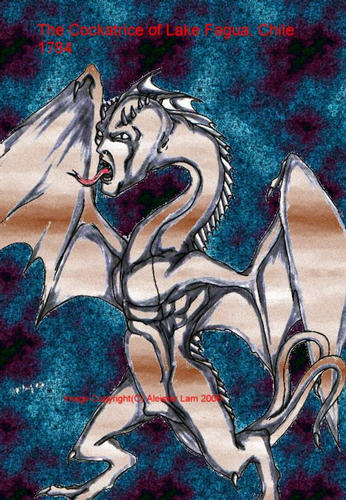 The Cockatrice of Lake Fagua
The Cockatrice of Lake Fagua
In early 1784, a strange creature with human facial features, spouting two serpentine tails and a pair of bat-like wings and deadly talons was seen at Lake Fagua. Its teeth were some 30 cm long and the mouth could be opened to as wide as its face. The creature is said to appeared at the farm of one Don Prospero Elso near Lake Fagua located in San Vincente in Chile. It did great damages to the owner of the farm by devouring most of the livestock and then quench its thirst by drinking in the lake. The local authority despatched one hundred men with firearms and they hid in the nearby bushes; ambushing the unsuspecting monstrosity. Residents of San Vincente reported that though the creature was captured alive but such a creature of unnatural disposition would not be displayed in captivity; it vanishes, probably escaped and never to be seen again. Strangely, in several texts which I had come across depict this man faced monstrosity as a Cockatrice, and hence the title 'The Cockatrice of Lake Fagua'. And most of these books also would list the Cockatrice or Basilisk as a sort of dragon probably because of its deadly breathe and gaze, mostly attributed to the dragons.
|
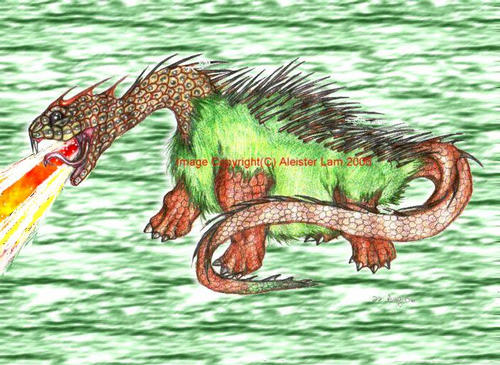 The Peluda
The Peluda
Prior to The Deluge, all animals great and small were queuing up to board the Ark of Noah, but there was on animal that kept the wise man deep in thought. This was a animal with shaggy green fur and a deadly venomous quills on its back; it had short and stout legs that were like that of a terrapin. What worried Noah the most was that this creature had a short temper and when agitated it would breathe fire and spat out a deadly acidic fluid at its enemies; posing a great danger to the other animals on the Ark. Eventually Noah tricked the animal into believing that they would set sail at dusk but in actual fact he had already boarded all the other animals on his Ark and set out to sea at dawn. Stranded alone when the Great Flood came, the Peluda as this animal was known, struggled to stay alive vowing to take vengence on man for forsaking him. Amphibious in nature and protected by its thick hide, the Peluda was able to propel itself using its thick and serpentine tail. The exhaustive swim in the vast ocean, considerably weakened its tail; leaving it the only vulnerable spot in the creature's inpenetratable armoured body. It was only until the Middle Ages that the Peluda emerged from its cave and hid itself along the banks of the
River Huisne in France. For the anguish caused by its exclusion from the Ark during The Deluge, it turned its anger on pure and innocent human beings, thus it acquired a special liking for young maidens and children. The French called the monstrosity the La Velue, while others called it the Shaggy Beast, due to its appearance. Primarily driven by its hatred for men, it raided farms, stables and villages. It withered crops with its fiery breath and would trampled its victims with its powerful broad hooven feet. The Peluda finally met its match when a young man who lost his beloved fiancee to the monster seek advice from a local seer. The wise man informed the intrepid youngster that the only way to rid the Shaggy Beast is by cutting off its tail with single strike; its only vulnerable spot. The young man enlisted the help of several blacksmiths who put their skills to test by making the sharpest and lightest broad bladed sword they have ever seen. The sword is essential in order for the young man to killed the Peluda in one single swipe. The grieving man practised day and night till he was comfortable with wielding such a huge blade before setting out to slay this heavily armoured beast. La Velue is classified as a dragon though its wingless and earth-bound simply because it had a reptilian head and a tail that is like that of a dragon.
|
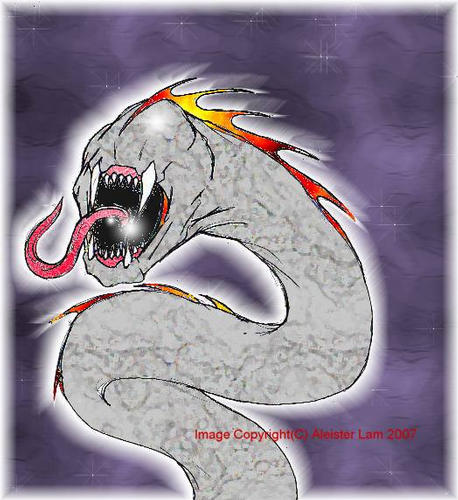 The Guivre
The Guivre
The Guivre is a French word for a extremely venomous limbless dragon that inhabited vast lakes, marshes and rivers because of its enormous size and length. Very much like a constricting serpent, it draws its pleasure from killing by first crushing its victim; enveloping it in coils and slowly suffocating it. It also has a highly toxic breathe that is able to shrivel crops and choke both men and the biggest of beasts within minutes. The Guivre is an extremely vicious and cannibalistic race of dragon in that even in the mother guivre's womb, if the pregnant female dies without giving birth, the baby guivres in her body will try to gnaw its way out of her womb and survive subsequently by feeding on the mother's carcass. Another unique attribute of this both legless and wingless wurm-like dragon is its ability to rejoin the various segment of its bodies after it had been hacked into several pieces; and thus a formidable dragon dreaded by most knights during the medieval times.
|
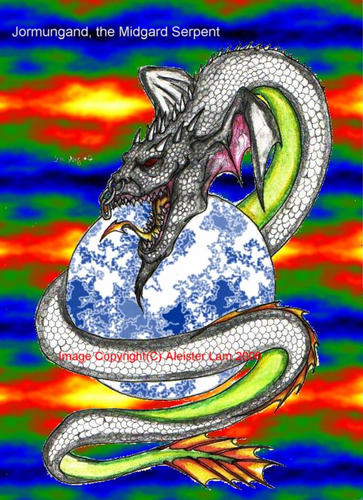 Jormungand, the Midgard Serpent
Jormungand, the Midgard Serpent
The Offspring of the trickster god, Loki and the giantess Angerboda, the Midgard Serpent, Jormungand is a giant monstous serpent grew to a size so huge that it was able to circle the world as depicted in the picture. The first encounter with the Thunder god, Thor, he tried to fished Jormungand out of the water by baiting it with an ox-head.Thor tried to smash the monstrous serpent with his magic hammer, Mjollnir but the frightened frost-giant and Thor's fishing companion, Hymir cut off the line and let it escaped. The two arch-enemy are said to meet one last time at Ragnarok, the end of the Norse world, where Thor will deal one last fatal blow to the evil Jormungand and himself poisoned by the deadly breath of the monster, only to die after taking seven steps.
|
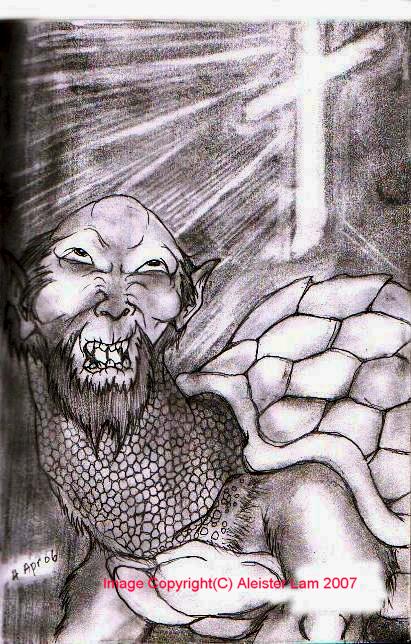 The Tarasque
The Tarasque
More Information will be updated later.
|